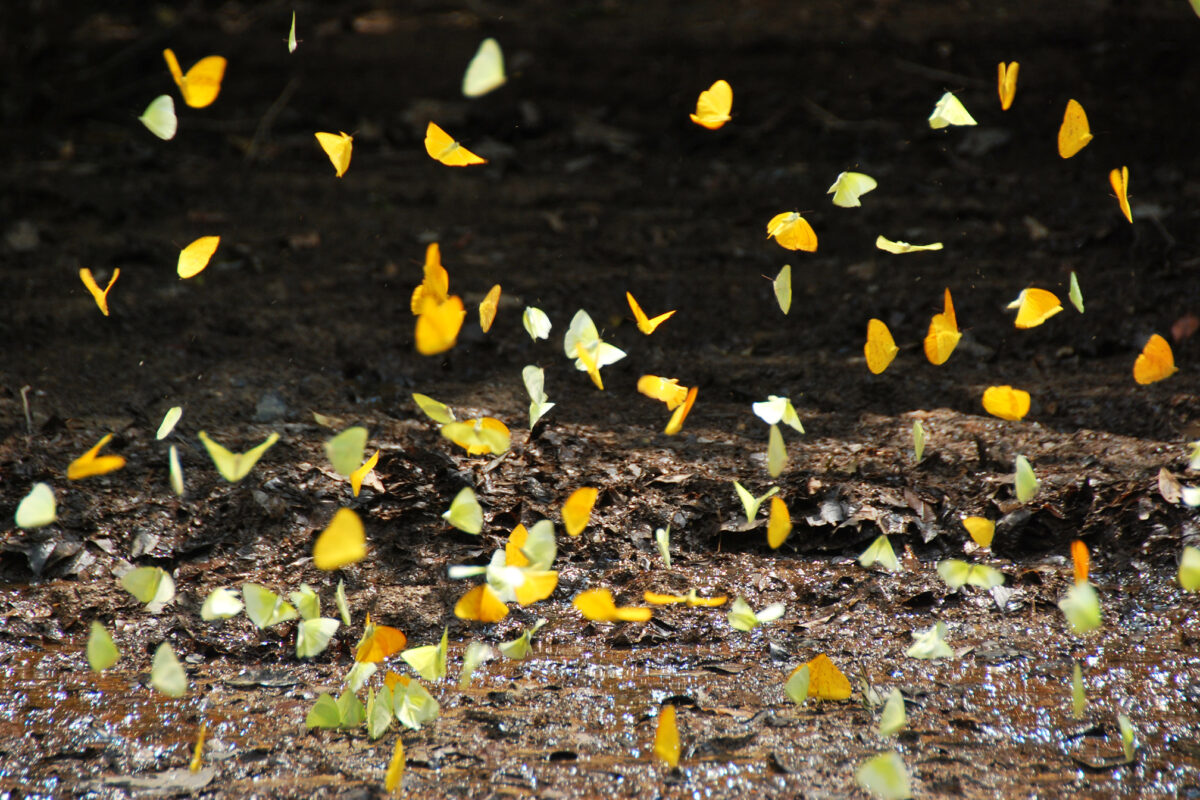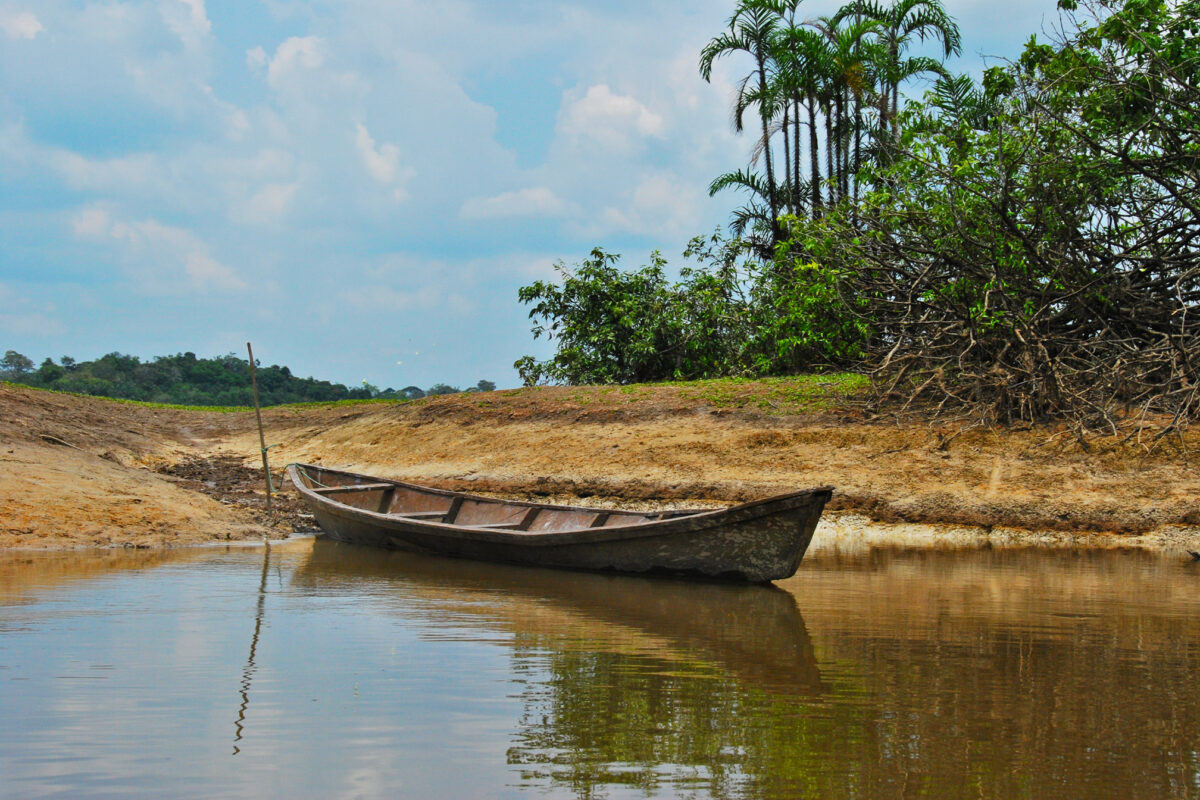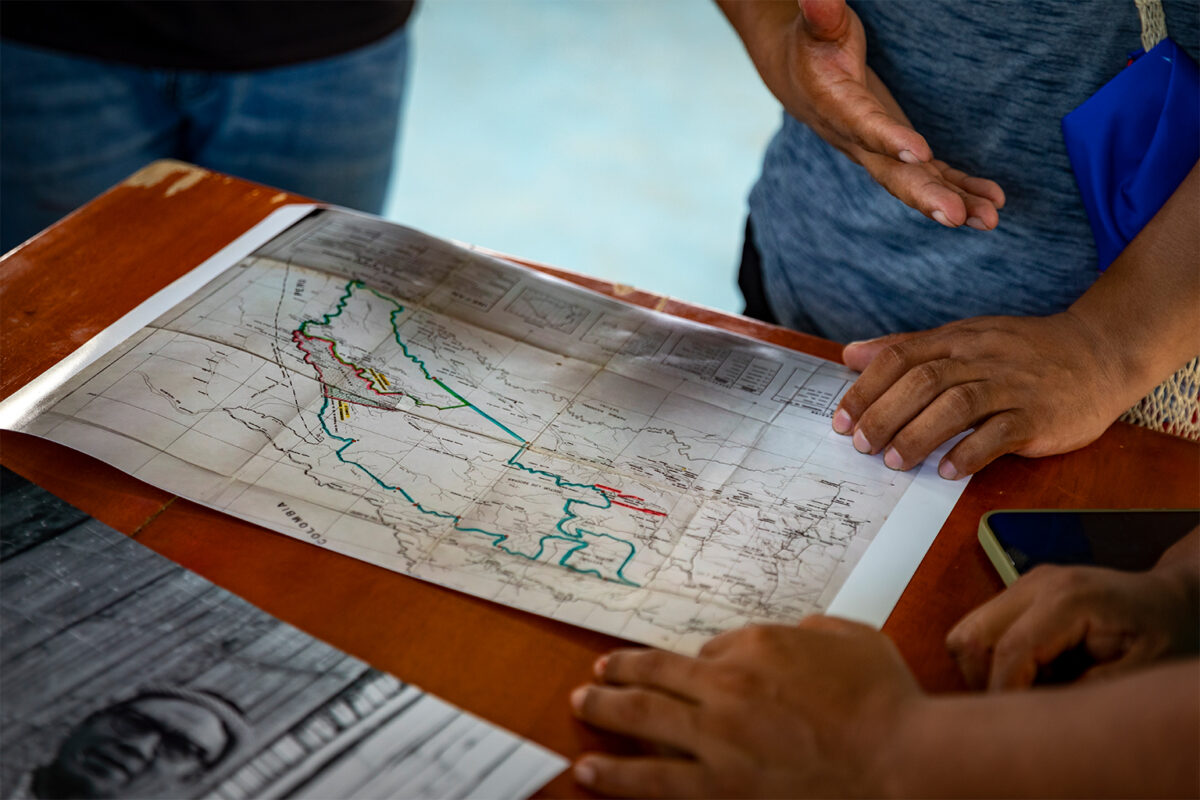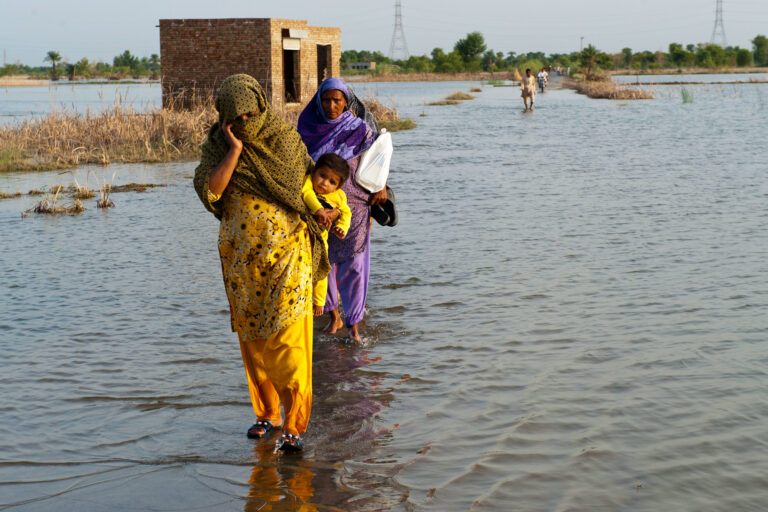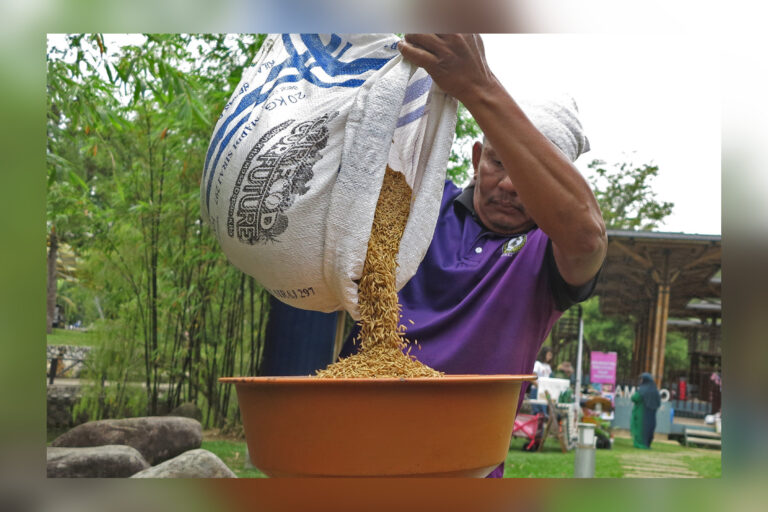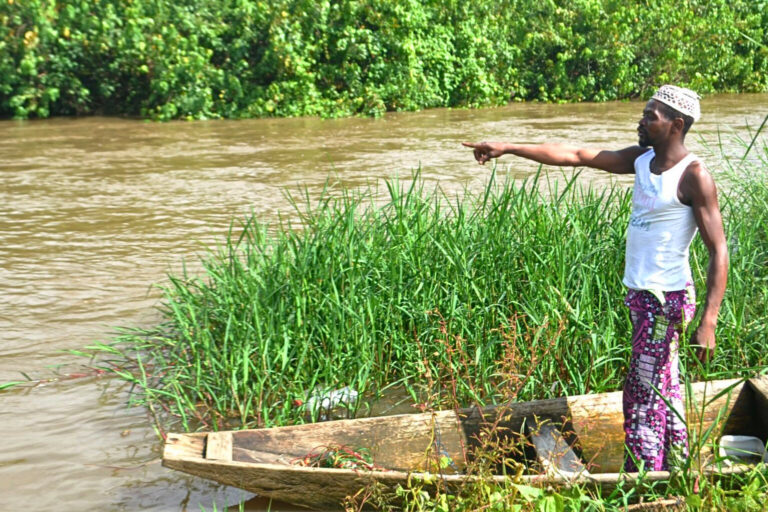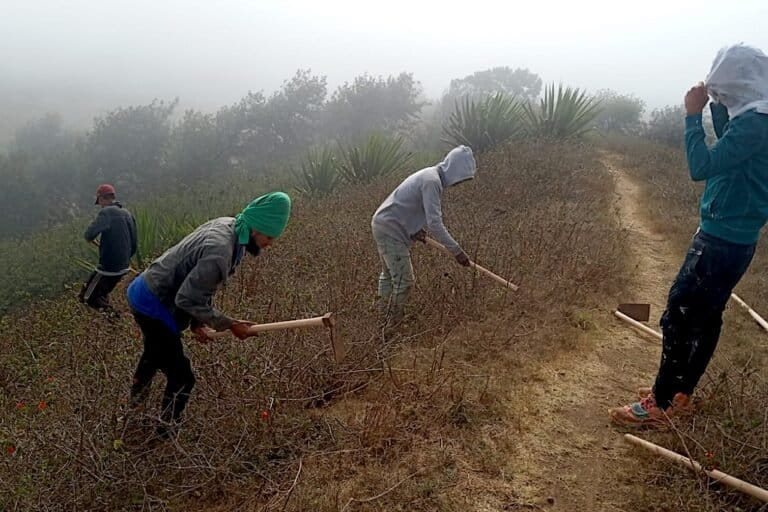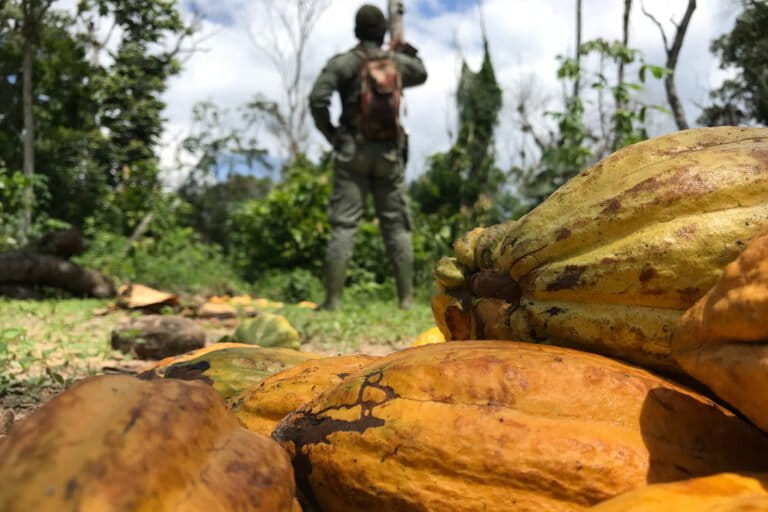- Last June, North Konawe, a land of hills and valleys on the Indonesian island of Sulawesi, was struck by devastating floods, displacing thousands of people.
- In the wake of the disaster, a public debate has ensued over the cause. Some government agencies have concluded that deforestation by plantation and mining companies exacerbated the floods.
- Some villages, including the riverside community of Tapuwatu, were almost completely washed away.
TAPUWATU, Indonesia — Muhammad Arfa says he thinks a miracle saved his home.
A wave of mud that swept through this riverside village on the Indonesian island of Sulawesi when floods ravaged the area last June razed dozens of his neighbors’ houses down to the foundations. Today there’s little left but upturned trees, scattered roofing material, and muddy marks high up the trunks of the coconut trees, a reminder of the height of the water.
“It was the very end of Idul Fitri, the rain didn’t stop,” the 46-year-old said from his porch, referring to the holiday that marks the end of the Islamic fasting month of Ramadan. At first, the 2-meter-high (6-foot) stilts holding up his house kept the water from entering. But as the waters rose and fell, the rain persisted for three days.
“Then the water starting rising again, so I told my family to grab their clothes and get in a boat.” When Arfa returned a week later, after the floods had receded, the mud line had reached the ceiling of his home, some 4 meters above the ground. Most of the other houses in the village lay in ruins.
Almost 20,000 people were affected by the floods that struck North Konawe, a hilly district in Southeast Sulawesi province, according to government figures. No one is known to have died, but thousands were displaced. When Mongabay visited the area with the national disaster agency last month, refugees living in makeshift tarpaulin shelters were salvaging what they could from the wreckage on the banks of the Lasolo River. Officials have proposed to create entirely new villages for the approximately 700 families who need new homes.
In the wake of the disaster, a public debate has ensued over its causes. Many are pointing the finger at the agribusiness and extractive companies clearing rainforest in North Konawe.
Trees hold the soil in place, preventing erosion that clogs up rivers with earthy material, a process known as silting. A river polluted by excess sediment is more likely to overflow, so damaging the forest in a river’s headwaters can increase the risk of flooding downstream.
LAPAN, the Indonesian space agency, has released satellite imagery showing that 370 square kilometers (140 square miles) of forest in North Konawe, an area bigger than Philadelphia, was cleared from 2013 to 2018. Much of this deforestation occurred upstream of Tapuwatu, and nearly all of it was due to plantation development, according to Rokhis Khomarudin, the head of the agency’s remote-sensing division.


While Rokhis was reluctant to say conclusively whether the deforestation exacerbated the flooding, a report being prepared by the ombudsman of Southeast Sulawesi province, seen by Mongabay, says that “generally the cause [of the flooding] was land conversion for plantations, mining and illegal logging.” The assertion reflects the views of groups like Walhi, Indonesia’s biggest environmental NGO, which also believes the disaster was “caused by the extractive industries,” says campaign manager Dwi Sawung.
An analysis of the floods in June by the Ministry of Environment and Forestry names “river silting” and “oil palm plantations” as among the causes of the disaster.
Extensive mining along North Konawe’s coast may also be a factor. The mining has fueled silting near the mouth of the Lasolo River, resulting in a “backwater effect” that further exacerbated the floods, the ministry’s report says.
“If someone says that the mine doesn’t damage the environment, it’s wrong,” Laode Syarif, a deputy head of the nation’s anti-corruption agency, said at an event in Kendari, the provincial capital, in June. “Environmental damage occurs from upstream to downstream as a result of mining.”
Others have been more hesitant to attribute the floods to widespread land-use change. At the event in Kendari, Southeast Sulawesi Governor Ali Mazi declined to assign blame for the disaster (other than to attribute it to “God’s will”), promising instead to form a team to look into the causes.
Ruksamin, the head of North Konawe district, similarly warned against jumping to conclusions, though he acknowledged that silting in the rivers had become serious.
“What we know for certain is that there was a lot of rain during those three days,” he told Mongabay in Tapuwatu, as disaster recovery teams worked to clear mud from people’s homes. “If the rivers are not deep enough, we can dredge them.”

Medi Herlianto, director of emergency services at the national disaster agency, compared the flooding in North Konawe to the floods that struck Bengkulu, on the island of Sumatra, in May, killing 30 people and displacing thousands. Environmental groups there blamed the disaster on coal mining upstream.
“We have to learn from the incident [in Bengkulu],” Medi told Mongabay. “There the environment was damaged, so we had to focus on reducing the vulnerability of areas to the impacts of disaster. But in Indonesia, the local government is the most responsible. The local government has to be the one to prohibit land conversion.”
Tapuwatu sits right across the river from a giant oil palm estate owned by PT Sultra Prima Lestari, which belongs to members of Indonesia’s billionaire Widjaja family, corporate records show. The ombudsman’s report names the firm as among those that have contributed to silting in the rivers. The company could not be reached for comment.

Farther upstream, in the village of Asemi Nunulai, residents have been protesting against a sugar plantation company they say is clearing forest without the required permits. A company spokesman identified as Ardi denied it had begun operating in any capacity because it didn’t have an environmental permit. The company, PT Aman Fortuna Nusantara, is thought to be an arm of the Jhonlin Group, a conglomerate owned by the Indonesian tycoon Andi Syamsuddin Arsyad, better known as Haji Isam.
“We anticipated that the flooding was going to occur before it did, because we see so much timber being taken from the highland forests,” Asemi Nunulai resident Husni Ibrahim, 37, told Mongabay by phone from the village. “I have never seen flooding like this in the 37 years I’ve lived here.”
Many companies operating in North Konawe received permits from the district’s former chief, Aswad Sulaiman, who is now in prison for corruption related to a construction project. Two years ago, Aswad was charged by the nation’s anti-graft agency with accepting bribes in exchange for issuing permits to mine nickel. That case is still ongoing.
One problem, says Henri Subagiyo, executive director of the Indonesian Center for Environmental Law, is that the government lacks a system for assessing the collective impact of many companies on the environment. A company that wants to mine or build a plantation must carry out an environmental impact assessment. But those studies are considered individually, with no holistic overview of the combined impacts of several companies operating in a given area.
“For example, the floods can’t be said to have been caused by only one company,” Henri said at his office in Jakarta. “In Indonesia, the weakness is making a policy that’s macro-level.”

Displaced people in Tapuwatu have been receiving food from the disaster agency as they wait for new housing, but some whose homes were consumed by mud still go without electricity, phone service and showers. Rather than fixing the land destroyed by flooding, district chief Ruksamin said, the government will resettle those impacted, even if houses can be rebuilt. More flooding may only be another heavy rain away.
If more companies that have already received permits start operating, the floods could get even worse, said Mastri Susilo, the province’s ombudsman.
“We’ve urged the local government offices to do more research into this, because we need to know how to prevent this,” Mastri said in an interview at his office. “It might be that we need more mining reclamation projects [to rehabilitate land no longer mined] or that we don’t give out anymore plantation permits.”
Masriyani, a 38-year-old mother of three who found her home in Tapuwatu filled to the windows with mud, says she doesn’t know how her family can earn a living now.
“We need heavy-duty equipment to fix the rice fields,” she said. “It’s all sand mixed with dirt now. We can’t plant rice there.” She’s cleaned out the mud from her house, but the destroyed furniture means it’s still far from becoming a home again.

Some in Tapuwatu are not opposed to leaving it behind. It’s a young village, built only 15 years ago to support the oil palm plantation nearby.
“I think it’s true that people are clearing land recklessly in North Konawe,” Arfa said. “But there will be no one sad to leave this place.”
Follow Ian Morse on Twitter: @ianjmorse
FEEDBACK: Use this form to send a message to the author of this post. If you want to post a public comment, you can do that at the bottom of the page.


